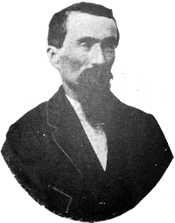January 28 — Early this morning we started toward Harper’s Ferry, through a cold and drenching rain. We got wet, and our clothes were stiff with ice, which put us in a first-class condition for fight — as wet hens fight well.
When we got to Bolivar near the Ferry the rain had ceased, but a heavy mist hung like a lacy pall over the river, through which we could dimly discern a Yankee encampment on the Maryland side, and near the canal I saw the bluecoats moving around among the tents, and from all appearances they were preparing breakfast. We went to the lower end of Bolivar and silently turned into a lot on the left of the street near a brick house and put our guns in position unobserved by the enemy.
We opened fire and landed a live twelve-pounder in their camp, which proved to be a regular surpriser. It stirred up the whole camp in general and stopped the breakfast business short off. I saw the men rush out of their tents, gazing about for a moment to ascertain where the unwelcome, noisy visitor hailed from. Just then we repeated the dose with another twelve-pound percussion shell.
They seemed then to comprehend that we meant business. They had also located our position, and hastily seizing their long-ranged rifles they ran hurriedly down the hill to the canal, some of them behind trees along the river, and opened fire on us. We were in range of their rifles, for I heard the dull thud of the bullets as they struck the ground around us. We fired five rounds, and then retired from our exposed position. After we ceased firing I heard it thunder over on Maryland Heights, and I also heard a few nailkegs whiz fearfully through the air. The Yanks had a battery of heavy rifled guns — twenty-four-pounders, I think — in position halfway up the mountain on the Maryland side, from which they fired some eight or ten rounds. They did not fire at our battery, but threw all their shell to our right; I suppose at some of Ashby’s cavalrymen. After the firing all ceased we returned to Charlestown, and are again quartered in the Court House.
The natural scenery around Harper’s Ferry is strikingly grand and picturesque. There the bright waters meet and laughingly lave the foot of a disrupted mountain. The Loudoun Heights spring from the right bank of the Shenandoah, like a mighty giant adorned in the sylvan garb of primeval splendor, and lifts its rocky crest far above the murmuring rapids of the river, and watches the Daughter of Stars mingle its limpid waters with the River of Swans. On the opposite side of the Potomac Maryland Heights lifts its craggy head still higher and pushes boldly out its adamantine breast till it almost overhangs the rushing river, and like a faithful sentinel it ever guards the single gateway that permits the waters of the Shenandoah and Cumberland valleys to pursue their winding way to the sea.
Bolivar Heights, with its Jefferson’s Rock apparently hanging in the air, lends enchantment to the scene of rippling silvery waters rushing around huge boulders in the river, and a rifted mountain with its rugged breach and delectable environments, where nature revels in her wildest beauty.



